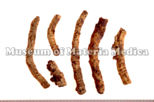Figwortflower Picrorrhiza Rhizome

|
TMPW No.:16210 |
| Synonym | |
| Latin name | Picrorrhizae Rhizoma |
| Botanical source: Family name | Scrophulariaceae |
| Botanical source: Plant name | - Picrorhiza scrophulariiflora Pennell (IPNI:808412-1) - Picrorhiza kurroa Royle ex Bentham (IPNI:808408-1) |
| Part used | Rhizome |
| Empirical criteria for quality selection | Unknown |
| Constituents | Monosaccharides: P. kurroa: D-Mannitol Monoterpenoids: P. kurrooa: Picroside I, Picroside II, Picroside III, Kutakoside; P. scrophulariiflora: Picroside IV Phenylpropanoids: P. kurrooa: Kutkin (=6-Cinnamyl-β-D-glucosidyl vanillate) Phenol derivatives: P. kurrooa: Apocynine Other aromatic derivatives: P. kurrooa: Vanillic acid; P. scrophulariiflora: Scroside A, Scroside B, Scroside C |
| Pharmacological effects | Protection of liver (picroside II), antiinflammatory |
| Indications | As an antifebrile, antidote, tranquilizer, stomachic and insecticide, it is used in treating convulsion of child, diarrhea, jaundice, hemorrhoids and inflammation of eye. |
| Diseases | Fever due to child malnutrition, Diarrhea, Jaundice, Hemorrhoid |
| Formulas | |
| Meridian tropism | Heart, Liver, Stomach, Large intestine |
| Property | Cold |
| Flavor | Bitter |
| Classification in "Shen-non Ben-cao Jing" | |
| TCM: Classification | Drugs for fever of deficiency type |
| TCM: Medicinal effects | To remove damp-heat, and to relieve consumptive fever.:For dysentery or jaundice caused by damp-heat, hemorrhoids, consumptive fever, and fever in infantile malnutrition due to digestive disturbance. |
| Remarks | |
| References |
